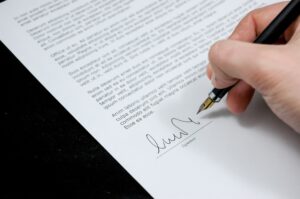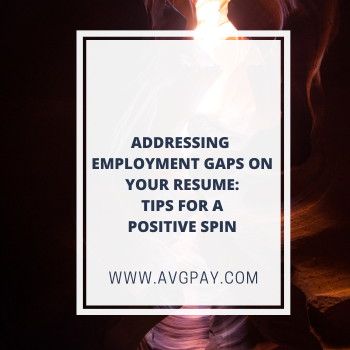When you’re preparing your resume, coming across an employment gap can feel like hitting a roadblock. It’s common to worry that these job gaps might turn off potential employers. But here’s some great advice: employment gaps don’t have to be a setback. In fact, with the right approach, you can spin these gaps in a positive way, turning what seems like a disadvantage into an opportunity to showcase your strengths and growth.
First, let’s understand what we mean by an ’employment gap.’ Simply put, it’s a period of time that isn’t accounted for by formal employment. This could be a few months or even a couple of years. Life is unpredictable, and there are many valid reasons for these gaps. Maybe you took time off for personal development, to care for a sick family member, or to pursue volunteer work.
Whatever the reason, it’s important to remember that career gaps are more common than you might think.
In this article, we’ll guide you through the steps to address these gaps on your resume. We’ll show you how to explain employment gaps in a way that reflects positively on your professional journey. It’s not just about the time you spent away from work, but what you did during that time and what you learned from it that counts.
So, let’s get you started on explaining employment gaps like a pro.
What are employment gaps?

An employment gap is any period when you weren’t working in a formal job. This might sound straightforward, but there’s more to it. Employment gaps can happen for many reasons – maybe you took a career break to focus on personal goals, or perhaps you needed to be a full-time caregiver for a family member. Understanding these gaps is the first step in addressing them effectively on your resume.
Let’s break down some common types of employment gaps:
Career Breaks
These are deliberate pauses in your professional career, often taken for personal development, pursuing new skills, or even traveling. A career gap can be a conscious choice to step away from the job market for a while.
Caring for a Family Member
Life sometimes calls us to prioritize family over work. Whether it’s caring for a young child or a sick family member, these are significant periods that can lead to gaps in formal employment.
Job Hunting Periods
After leaving a job, it might take some time before you land the next one. This period of job searching is also considered an employment gap.
Education and Training
Sometimes, you might take time off to pursue further education or professional training. These periods are valuable as they add to your qualifications and skills.
Unexpected Layoffs
Economic downturns or company restructuring can lead to unexpected job loss, resulting in an unemployment gap.
Most employers understand that career paths aren’t always linear. Employment gaps don’t define your professional worth; rather, they are part of your career story. Life events and personal choices can lead to gaps, and that’s okay. The key is how you present these gaps on your resume and during job interviews.
Writing Your Cover Letter

Your cover letter is a powerful way to address employment gaps in a positive light. It’s your chance to tell your story in a way that your resume can’t. Here, you can explain gaps directly, but remember, the goal is to focus on your growth and readiness for the new job, not just the gap itself.
Here are some tips for discussing employment gaps in your cover letter:
Be Honest but Brief:
Start by briefly acknowledging the gap. There’s no need for lengthy explanations. A simple, straightforward statement is enough. For instance, “I took a career break to care for a family member,” or “I spent some time furthering my education in [field/subject].”
Emphasize What You Learned
Turn the focus to what you did during this time that’s relevant to your career. Did you develop new skills, volunteer, or engage in professional training? Highlight these experiences and how they’ve prepared you for the job you’re applying for.
Show How You’ve Grown
Employers appreciate candidates who can turn challenges into opportunities for growth. Talk about how your experiences during the gap have made you a better professional. Maybe you’ve gained soft skills like time management or empathy, or perhaps you’ve acquired new technical skills.
Connect to the Job
Tailor your explanation to align with the job you’re applying for. For example, if you’re applying for a role that requires strong organizational skills and you spent your gap organizing community events, mention this.
Keep a Positive Tone
Your cover letter should radiate positivity and readiness for the new role. Avoid sounding apologetic about your employment gap. Instead, present it as a period of valuable experience and personal growth.
Your cover letter is not just a space to explain gaps; it’s a chance to showcase your strengths, experiences, and the unique qualities you bring to the table. By addressing your employment gap confidently and positively, you set the stage for a strong first impression with potential employers.
Preparing for the Job Interview

After writing your resume and cover letter, the next step is to turn your attention to the job interview. This is where you might face direct questions about your employment history, including any gaps. Preparing for these questions can help you handle them with confidence and turn potential concerns into demonstrations of your strengths and resilience.
Anticipate Questions
Think like a hiring manager. They might ask, “Can you explain this gap in your employment?” or “What were you doing during this period?” Prepare clear, concise responses in advance.
Practice Your Responses
Rehearse your answers, but keep them natural. You don’t want to sound scripted. The goal is to be comfortable discussing your employment gap in a way that feels honest and positive.
Focus on the Positive
Emphasize what you learned or achieved during your employment gap. Whether it was personal development, new skills, or volunteer work, discuss how these experiences have enriched you professionally.
Connect Your Experience to the Job
Illustrate how your activities during the gap make you a better fit for the role. For example, if you managed a project or led a team in a volunteer capacity, highlight how these leadership skills are relevant to the job you’re interviewing for.
Be Honest and Direct
If your gap was due to a personal or challenging situation, it’s okay to share that, but keep the details minimal. Focus on how you’ve overcome these challenges and are now fully prepared to re-enter the workforce.
Turn the Conversation Around
After addressing the gap, steer the conversation back to your strengths and the value you can bring to the company. Discuss your relevant skills, experiences, and your eagerness to contribute to the new role.
Employment gaps are only one part of your story. Your ability to discuss them openly and positively can demonstrate your true mindset in a way that many wouldn’t be able to.
By preparing thoroughly for these discussions, you can help hiring managers see past the gaps and focus on the value you bring as a potential employee.
Resume Formats That Work in Your Favor
Choosing the right resume format is important, especially when you have employment gaps. You need to focus on highlighting your strengths and skills while de-emphasizing the gaps. Let’s explore some resume formats and strategies that can help you present your work history in the most favorable light.
Functional Resume Format
Unlike the traditional chronological resume, a functional resume focuses on your skills and experiences rather than your chronological work history. This format is ideal for those with gaps in employment as it allows you to showcase your abilities and achievements upfront. For example, you can categorize your skills into sections like ‘Project Management’ or ‘Customer Service Excellence’ and list relevant experiences under each category.
Combination Resume
This format blends the functional and chronological styles. It starts with a skills summary, which is great for highlighting your abilities, and follows with a brief work history. This way, you can demonstrate your qualifications while providing a concise view of your employment timeline.
Highlighting Freelance Work or Volunteer Experiences
If you’ve done freelance work, volunteer activities, or taken on project-based work during your employment gaps, make sure to include these experiences. They count as valuable work history and demonstrate your commitment to staying active and engaged in your field.
Customizing Your Resume for Each Job
Tailor your resume to align with the job you’re applying for. Highlight the skills and experiences that are most relevant to the job description. This approach not only shows that you’re a good fit for the role but also draws attention away from any gaps in your employment.
Addressing Short Gaps
If you have small gaps (a few months), you might not need to mention them at all. Sometimes, simply listing the years of employment (instead of months and years) can effectively mask these short periods.
Turning Gaps into Opportunities

Employment gaps, often seen as obstacles, can actually be transformed into a positive. It’s all about reframing these periods as times of growth, learning, and development. Here’s how you can turn your employment gaps into opportunities:
Emphasize Personal Development
If your gap was a period of personal growth, talk about it positively. Maybe you took a course, learned a new language, or developed a new hobby. These experiences show your commitment to self-improvement and can be very appealing to employers.
Highlight New Skills Acquired
Did you gain new skills during your time off? Perhaps you engaged in freelance work, online courses, or volunteer activities that helped you develop professionally. Make sure to highlight these in your resume and during interviews. For instance, managing a fundraising event shows organizational and leadership skills.
Showcase Your Adaptability and Resilience
Employers value candidates who can adapt to changing circumstances and overcome challenges. Use your employment gap to demonstrate these qualities. Discuss how you navigated the period of unemployment, what you learned from it, and how it has prepared you for your next role.
Volunteer Work and Community Engagement
If you were involved in volunteer work, this could be a significant advantage. It shows a commitment to contributing to your community and can provide examples of teamwork, leadership, and other professional skills.
Frame Your Gap as a Strategic Career Move
Sometimes, a break is taken to reassess career goals or to pivot to a new field. If this was the case for you, explain how this period helped you refocus and align your career path with your professional goals.
The Perspective of Employers
Understanding how employers view employment gaps can give you a significant advantage when applying for jobs. It’s important to remember that employers are looking for the best fit for their team and company, and their perspective on employment gaps has evolved over time. Let’s delve into what employers typically think about these gaps and how you can address them effectively.
Changing Attitudes Towards Employment Gaps
In today’s job market, many employers recognize that career paths are not always linear. Life events, personal choices, and economic factors can lead to gaps in employment. Think of all the recent layoffs that have occurred. Many employees will have chosen other routes in their professional career, so you won’t be alone. A growing number of hiring managers understand this and are more interested in your current skills and future potential.
Honesty is Key
Employers appreciate transparency. Being upfront about your employment gaps can build trust. Most hiring managers are willing to consider the reasons for the gap, as long as you can demonstrate that you’ve remained productive and focused on your professional development during that time.
Focus on Recent Experiences and Skills
Employers are most interested in your recent work history and the skills you bring to the table. If your employment gap was several years ago and you’ve since gained relevant experience, the gap will likely be less significant in their decision-making process.
Employers Value Continuous Learning
If you used your time off to learn new skills, complete courses, or engage in professional development, make sure to highlight this. Employers often view candidates who are committed to learning and self-improvement favorably.
The Importance of Cultural Fit
Sometimes, how you fit into the company culture and work with the team can be as important as your professional experience. Use your employment gap to demonstrate qualities like resilience, adaptability, and a positive attitude, which are highly valued in any workplace.
Potential Red Flags
While many employers are understanding, long, unexplained gaps can be a red flag. So be prepared to explain career gaps in a way that alleviates any concerns about your reliability or commitment.
Bottom Line
Employment gaps don’t have to be a stumbling block in your career. They certainly shouldn’t prevent you from securing your dream job. With the right approach, you can turn them into a positive that shows how you’re different to other job seekers.
There you have it. We hope you enjoyed this article. Hopefully, you’re now in a better position of creating a resume that converts. For more advice on mastering the job search, feel free to browse the rest of our site..





